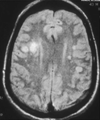The variegate neurological manifestations of varicella zoster virus infection
- PMID: 23884722
- PMCID: PMC4051361
- DOI: 10.1007/s11910-013-0374-z
The variegate neurological manifestations of varicella zoster virus infection
Abstract
Varicella zoster virus (VZV) is an exclusively human neurotropic alphaherpesvirus. Primary infection causes varicella (chickenpox), after which the virus becomes latent in ganglionic neurons along the entire neuraxis. With advancing age or immunosuppression, cell-mediated immunity to VZV declines, and the virus reactivates to cause zoster (shingles), dermatomal distribution, pain, and rash. Zoster is often followed by chronic pain (postherpetic neuralgia), cranial nerve palsies, zoster paresis, vasculopathy, meningoencephalitis, and multiple ocular disorders. This review covers clinical, laboratory, and pathological features of neurological complications of VZV reactivation, including diagnostic testing to verify active VZV infection in the nervous system. Additional perspectives are provided by discussions of VZV latency, animal models to study varicella pathogenesis and immunity, and of the value of vaccination of elderly individuals to boost cell-mediated immunity to VZV and prevent VZV reactivation.
Conflict of interest statement
Figures




References
-
- Gilden DH, Dueland AN, Cohrs R, et al. Preherpetic neuralgia. Neurology. 1991;41:1215–1218. - PubMed
-
- Harnisch JP. Zoster in the elderly: clinical, immunologic and therapeutic considerations. J Am Geriatr Soc. 1984;32:789–793. - PubMed
-
- Gilden DH, Cohrs RJ, Mahalingam R. Clinical and molecular pathogenesis of varicella virus infection. Viral Immunol. 2003;16:243–258. - PubMed
-
- Tyndall MW, Nasio J, Agoki E, et al. Herpes zoster as the initial presentation of human immunodeficiency virus type 1 infection in Kenya. Clin Infect Dis. 1995;21:1035–1037. - PubMed
-
- Lapresle J, Lasjaunias P. Cranial nerve ischaemic arterial syndromes. Brain. 1986;109:207–15. - PubMed
Publication types
MeSH terms
Grants and funding
LinkOut - more resources
Full Text Sources
Other Literature Sources
Medical

